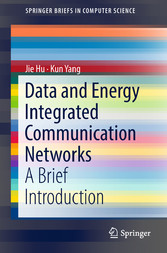Suchen und Finden
Preface
6
Contents
8
Acronyms
10
1 Data and Energy Integrated Communication Networks: An Overview
12
1.1 Energy Dilemma for Electronic Devices
12
1.2 Near-Field Wireless Energy Transfer
13
1.3 RF Signal Based Wireless Energy Transfer
14
1.4 WET Versus WIT in the RF Spectral Band
16
1.5 Ubiquitous Architecture of the DEIN
18
1.5.1 Heterogeneous Infrastructure
18
1.5.2 Heterogeneous User Equipment
19
1.5.3 Heterogeneous Techniques for WIT and WET
21
References
22
2 Fundamental of Integrated WET and WIT
25
2.1 Information Theoretical Essence
26
2.1.1 Discrete-Input-Discrete-Output Memoryless Channel
26
2.1.2 Continuous-Input-Continuous-Output Memoryless Channel
31
2.2 Transceiver Architecture of DEIN Devices
33
2.3 Signal Splitter Based Receiver Architecture
36
2.3.1 Ideal Receiver Architecture
36
2.3.2 Spatial Splitting Based Receiver
36
2.3.3 Power Splitting Based Receiver
38
2.3.4 Time Switching Based Receiver
40
2.3.5 Rate-Energy Region
42
2.4 Summary
43
References
44
3 Throughput Maximization and Fairness Assurance in Data and Energy Integrated Communication Networks
45
3.1 Introduction
46
3.2 System Model
47
3.2.1 Structure of the TDMA Aided Operating Cycle
48
3.2.2 Channel Model
50
3.2.3 Throughput of the Downlink Transmission
51
3.2.4 Throughput of the Uplink Transmission
51
3.3 Sum-Throughput Maximisation
52
3.4 Fair-Throughput Maximisation
56
3.5 Numerical Results
58
3.6 Summary
63
References
63
4 Joint Time Allocation and User Scheduling in a Full-Duplex Aided Multi-user DEIN
65
4.1 Introduction
66
4.2 Preliminary
67
4.2.1 Wireless Powered Communication Network
67
4.2.2 Full-Duplex
68
4.3 System Model
69
4.3.1 Network Model
69
4.3.2 Frame Structure
70
4.3.3 The Downlink WET and Uplink WIT
71
4.4 Problem Formulation
73
4.4.1 Sum-Throughput Maximisation
73
4.4.2 Iterative Algorithm
73
4.5 Performance Evaluation
76
4.6 Summary
79
References
79
5 Conclusions and Open Challenges
80
5.1 Conclusions
80
5.2 Open Challenges
82
5.2.1 Efficiency Enhancement of WET
82
5.2.2 Efficient Energy Storage
82
5.2.3 Heterogeneous Internet of Energy
83
5.2.4 Information Theoretic WET Capacity
84
5.2.5 Interference Cancellation and Signal Decoupling
84
5.2.6 Socially Aware Placement of DEIN Stations
85
5.2.7 DEIN Aided Mobile Cloud Computing
85
Index
86
Alle Preise verstehen sich inklusive der gesetzlichen MwSt.








